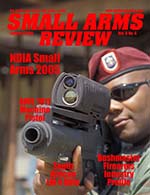By Dan Shea
An example of sustained fire, the Somme, 24th August, 1916
The following extract is taken from the Official History of the Great War, and will serve to show what the water-cooled Vickers gun is capable of when the need arises.
The 100th Machine Gun Company was in a position known as Savoy trench. The Company had ten Vickers guns and was ordered to support an attack with rapid fire. It was necessary to neutralize an area and prevent any enemy crossing it for twelve hours. The area was visible at 2,000 yards range. Two Infantry companies were lent to stock the position with ammunition and water, whilst two men, working continuously on a hand-driven belt-filling machine, kept the belts filled throughout the period. Factory filled belts were not supplied until the 1930's. 1,000,000 rounds; all but one belt were fired during the 12 hours. The ammunition expenditure was roughly as follows:
* Average rounds per gun 100,000
* Average rounds per gun per hour 8,300
* The best gun fired a total of 120,000 rounds (40 belts or 10,000 rounds per hour.)
There were no major breakdowns, and all the guns were in action at the end of the barrage, but the water only just lasted. It should be noted that the figure of 8,300 rounds per gun per hour included the time required for curing stoppages, loading belts, and relaying when necessary. In addition the water jackets had to be topped up, and the barrels would be changed about once an hour. The life of the barrel, under such conditions, it about 10,000 rounds, so over 100 barrels must have been used by the Company. - "Pistols, Rifles and Machine Guns" by Major W.G.B. Allen, s.a.c., The Loyal Regiment, 1953
Frequently, we hear discussions about what sustained levels of fire for machine guns are. I ran across the above description of an early area denial strategy that solely used the Vickers guns, and thought our readers might enjoy the data that had been extrapolated from the event on the Savoy Trench. Compare that to what our guns are expected to do in the modern military. It's not really a fair comparison, because their machine guns could be water cooled, and weigh a hundred pounds with tripod etc. One really does give up a lot of potential when going to Air Cooled.
Q- I need some information on how to remove the barrel from a Yugoslav M56 SMG. This gun has a rather unusual looking barrel locking nut. Looking from the top there is a screw that obviously has to be removed. But there are also notches at the bottom on both the nut and the receiver that are aligned. Does this gun use a barrel washer system? Are any special tools needed to remove the barrel? Is there an exploded view drawing available?
A - There are a lot of the 7.62x25mm Tokarev caliber Yugoslav Model 56 submachine gun parts sets coming into the United States right now. They are a tube gun with roots in the German MP40, and are quite interesting. They make a good platform for a semi automatic rifle with either a longer barrel, or as a registered Short Barreled Rifle, as long as you have an ATF approved semi-automatic build-up for the fire control system. There have been a lot of questions on the barrel removal, and I checked to see if there were any resources on the Internet I could guide you to. Unfortunately, most of them had wrong information or missed the boat on how to disassemble this section without damaging the relevant parts, so, I just took a kit and set it up for proper parts recovery.
First, you have to understand that the barrel has to be removed backwards - out through the receiver. Outwardly, it camouflages that fact because the barrel nut looks like it holds the barrel in from the front. One would guess from looking at it that the barrel nut threads onto the trunion and secures the barrel: that is not correct. That rearward removal means step one is to drive out the pins that hold the bayonet lug and front sight on the barrel. Once these two items have been removed, then the barrel will be ready to remove to the rear. Follow the steps in the pictures and good luck on the project. I predict that due to the thousands of M56 available overseas or in the US already, that there will be some production semi autos as well.
Q- I couldn't make out the details of the F1 submachine gun in Raffica (Vol. 9, No. 1, Oct. 2005, page 21) that Bill Vallerand was holding. Can you give us a better look at it?
A- The Australian F1 is a unique and interesting gun combining the features of the Sterling, the Austen and the Owen. They are very rare in the United States and I don't recall seeing any registered transferable guns. I plan on doing a feature on the F1 in the future. I have watched for these in museums, and recently noticed one in the Pentagon foreign armies display cases. To your question, here are three pictures that should give you a better understanding of the outward appearance of the F1. (Photos are by Dan Shea, courtesy MOD Pattern Room)
Send questions to: Raffica sareview@aol.com
Or mail to Small Arms Review
Attn Raffica
631 N. Stephanie St #562
Henderson, NV 89014
This article first appeared in Small Arms Review V9N4 (January 2006) |
| SUBSCRIBER COMMENT AREA |
Comments have not been generated for this article.












